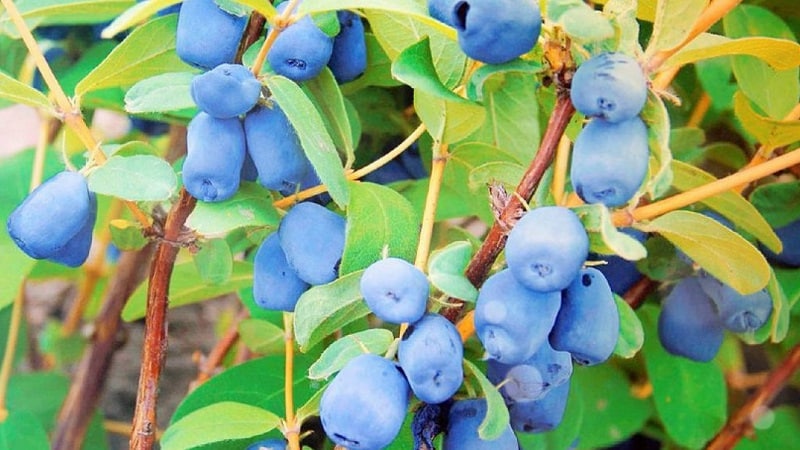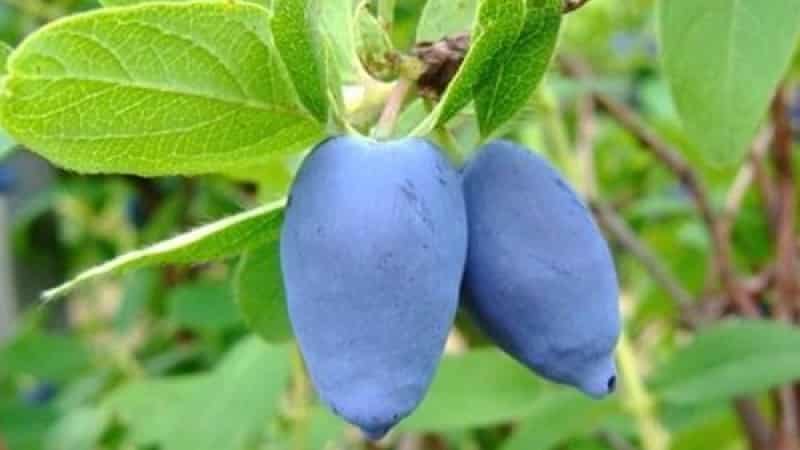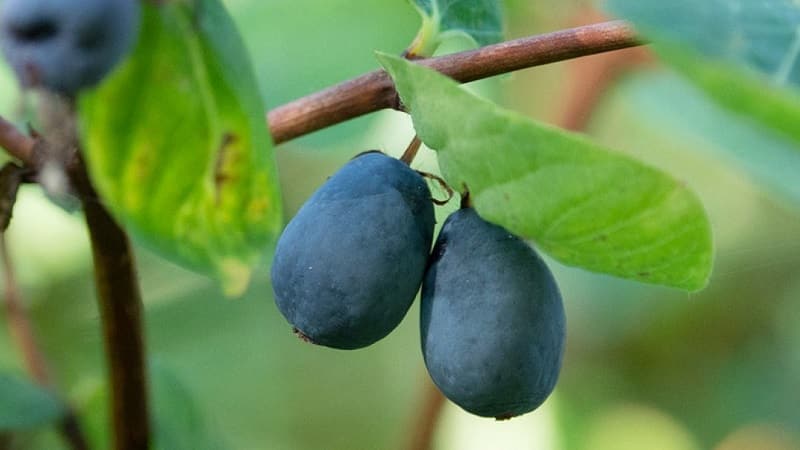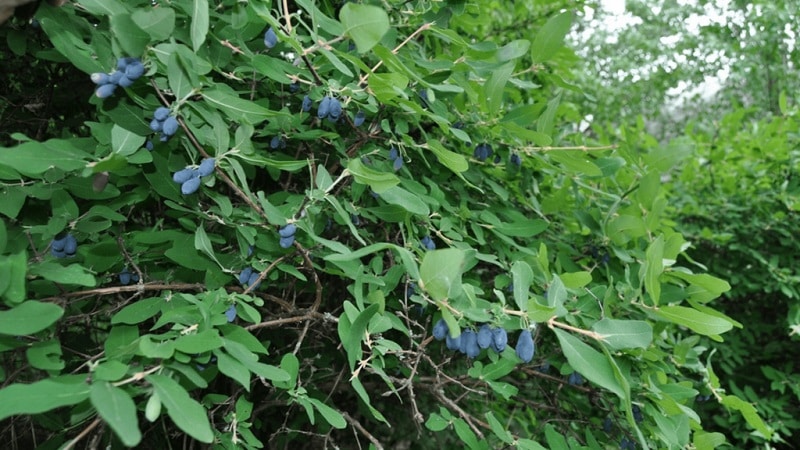Early ripening variety of honeysuckle Slavyanka
Not many gardeners grow honeysuckle on their plots, as it has a characteristic bitterness and sour taste. At the same time, the berry is rich in vitamins and minerals, and does not require special care when grown. Particularly popular is the Slavyanka variety, which has several advantages over others.
Description of edible honeysuckle variety Slavyanka
Thanks to its characteristics, the Slavyanka variety is loved by many gardeners.
Origin and development
The variety of this berry crop was bred at the Pavlovsk experimental station breeders of the Federal Research Center of the All-Russian Institute of Plant Genetic Resources named after. N. I. Vavilova (VIR) (St. Petersburg). The variety received the best qualities from its ancestors - Primorsky honeysuckle (elite form No. 21-5) and Leningrad giant.

Chemical composition and beneficial properties
Due to its low calorie content - 40-45 kcal/100 g - this berry is suitable for a diet menu. 100 g of honeysuckle contains a high concentration:
- vitamin A (0.07 mg);
- vitamin C (30 mg);
- vitamin B1 (3 mg), B2 (3 mg);
- beta-carotene (0.42 mg);
- potassium (70 mg);
- calcium (19 mg);
- magnesium (21 mg);
- phosphorus (35 mg);
- iron (0.8 mg);
- iodine (0.01 mg);
- manganese (0.09 mg);
- copper (0.09 mg);
- mono- and disaccharides (8500 mg).
There are more than 100 species of honeysuckle in the world, but most of them are not suitable for consumption. and even poisonous. Various varieties of edible blue honeysuckle (Lonícera caeruléa) are used for growing in gardens.
Even in Ancient China, the beneficial properties of this berry were noted. It is recommended to use it for:
- removal of toxins;
- prevention of urolithiasis;
- improving the functioning of the gastrointestinal tract;
- fight inflammation and reduce temperature;
- reducing swelling;
- improving metabolism;
- prevention and improvement of the cardiovascular system (normalization of blood pressure, strengthening the walls of blood vessels, improving blood circulation, lowering cholesterol levels);
- treatment of dermatological diseases;
- restoration of immunity;
- prevention of cancer.
Features of application
Berries of the Slavyanka variety are used both raw and canned.. You can eat fresh fruits, grind them with sugar or prepare juice, jelly, or fruit drink.
No less useful frozen or dried berries, jams and preserves, since after heat treatment most of the vitamins are preserved.
Attention! Up to 80% of useful substances are retained in honeysuckle after processing.
In addition to the fruits themselves, leaves, buds, flowers and roots are used. They are added to tea.
Honeysuckle is also used in cosmetology for fight inflammation, acne, spider veins and maintain youthful skin. The pulp or juice from the fruit is mixed with masks, creams, shampoos, lotions and tonics.
Eating honeysuckle may cause diarrhea or constipation in some cases., the development of allergies, decreased blood pressure, a sharp increase in red blood cells and an increase in hemoglobin. Honeysuckle is contraindicated:
- pregnant and lactating women;
- having allergies;
- children under 3-5 years old;
- with exacerbation of gastrointestinal diseases;
- people with low blood pressure.

Ripening period
The Slavyanka variety is mid-season - the berries ripen on average 40 days after setting. Depending on the region, fruits are harvested from the end of June (in the southern regions) to the beginning of August (in Central Russia, the Urals and Siberia).
Productivity and fruiting
Many gardeners like Slavyanka because of its high yield. Under proper growing conditions, on average, from 1.5 to 2.5 kg of berries are harvested from a bush. This variety bears fruit annually for several decades and does not require periodic changes of location.
Resistance to diseases and pests, cold and drought
This variety of honeysuckle has high disease resistance, but with improper care (lack of fertilizers, insufficient or excessive watering), the berry crop is often exposed to fungal diseases. Insect pests it is damaged infrequently; it is mainly attacked by aphids or mites.
Honeysuckle Slavyanka can withstand frosts down to -45...-50°C and short droughts up to +30°C.
Appearance and taste
Slavyanka bush is erect, obverse-conical, vigorous, with vertically growing branches. He grows up up to 1.5-1.9 m, and the crown width does not exceed 1 m. Slightly pubescent branches have a light pink color and good foliage.
Sami The leaves of this variety are large in size and have an oval shape with a pointed end., wavy leaf surface and dark green color. They are often located on branches and on both sides.
The edible berries are large in size and have a broad spindle-shaped shape. (rounded top and narrow base), blue/blue color, thick wax coating. The fruits grow up to 3 cm in length, their weight is up to 1 g.The skin of the fruit is thin and slightly lumpy, the flesh is tender and watery.
Important! Honeysuckle is often used in landscape design because during flowering small flowers with a pleasant aroma appear.
The taste of Slavyanka is sweet and sour, the bitterness characteristic of honeysuckle is absent, the berries also have a delicate aroma. Tasting score – 4.5 points.
For which regions is it best suited?
Due to its characteristics, this variety is recommended for cultivation in garden plots. central Russia, Siberia and Ural. Slavyanka adapts well to any climatic conditions: it is frost-resistant, tolerates drought well, and is not afraid of autumn frosts and thaws.
Advantages and disadvantages of the variety
Gardeners prefer Slavyanka for the following merits:
- does not require special care (only timely watering, pruning and fertilizing);
- has high yield (up to 2.5 kg per bush);
- bears fruit for several decades;
- the berries are large with a sweet and sour taste, thin skin and delicate aroma;
- the fruits stay on the bush for a long time after ripening;
- high adaptability to any climatic conditions (resistant to severe frosts and drought);
- low susceptibility to diseases and pests;
- tolerates transportation and long-term storage well;
- the bush does not need staking.
Among the shortcomings - necessity annual pruning mature shrubs.
Difference from other varieties and hybrids
Main differences:
- small size of the bush that does not require tying;
- large fruits with thin skin, soft and juicy pulp, sweet and sour taste, delicate aroma and no bitterness;
- the berries do not fall off after ripening, are easily transported and are suitable for consumption raw and canned;
- high resistance to weather changes (frost, drought), various diseases and pests.

Agricultural technology
Although Slavyanka is considered an easy-to-care variety, for annual fruiting and high yields it is necessary to follow the growing rules.
Choosing a place in the garden and preparing holes
For honeysuckle it is recommended to choose sunny or slightly shaded area.
Attention! If the shrub grows in the shade, the fruits will have the bitterness characteristic of honeysuckle.
The area chosen for planting is cleared of weeds, a hole with a diameter of up to 50 cm and a depth of up to 60 cm is dug in it and filled with compost or manure.
Soil requirements
Soil for this variety must have looseness, the ability to retain moisture and high acidity (pH less than 5.5) - loamy or sandy loam soils are suitable. The earth also needs to be enriched with minerals. To do this, use manure or fertilizer of plant origin (from chickpeas, peas, nettles).
Dates, scheme and rules of planting
In spring or autumn period Slavyanka is planted in the ground so that the seedling has time to take root..
It is not recommended to plant honeysuckle close to other plants – it is necessary to leave a small space (up to 1.5 m) for its growth and ventilation.
The hole prepared in advance is moistened, the seedling is carefully installed and covered with the remaining soil. The top of the soil is sprinkled with sawdust or hay is laid to limit the growth of weeds and retain moisture.
Afterwards, the seedling is pruned if necessary, giving the shape of the bush.
Features of cultivation
This variety of honeysuckle is unpretentious in care – It is enough to water, apply fertilizers, loosen the soil and trim old branches in a timely manner:
- The bush does not need additional shelter for the winter.
- There is no need to prune the bush in the first years, only to form the shape, make all branches the same height (30-40 cm above the ground). This will allow the bush to produce young shoots. After 5-6 years, pruning should be done annually. To do this, remove old branches that are damaged and thickened, allowing young shoots to form.
- Annually the bush is fed. Nitrogen fertilizers are applied in parts: half the dose in the spring, and the rest after harvesting. Phosphorus, potassium and magnesium are also periodically added. Once every 2 years, fertilize with well-rotted manure.
- Slavyanka loves moist soil and especially needs water during the flowering and ripening period, so under normal weather conditions it needs moderate watering up to 3-4 times a season. In drought conditions the frequency increases. On average, up to 10 liters of warm water per shrub is required. Do not pour the entire volume under the root at once, but gradually, allowing the water to seep through to the entire root system.

Pollinators
Honeysuckle variety Slavyanka is partially self-fertile. For stable fruiting and high yield in one garden plot, it is recommended to plant Blue spindle, Berel, Aurora, Kamchadalka, Viola, Nymph, Leningrad giant, Roxana, Avachu, Cinderella.
Disease and pest control
Despite the variety’s resistance to diseases and pests, sometimes bushes are affected:
- Powdery mildew (fungal disease). It appears as a white powder coating on the leaves, which then causes them to dry out. This is due to poor lighting, ventilation and high humidity.For control, various fungicides are used, spraying the entire plant once every 10-14 days.
- Aphid. Settles on the upper young parts of the bush. This causes yellowing and curling of the leaves. The affected areas become covered with sticky insect secretions. Insecticides are used for treatment. Spraying is stopped 2 weeks before harvest.
Difficulties in growing
When growing Slavyanka a problem such as leaf wilting may occur. This is caused by one of several reasons:
- lack of minerals and vitamins (nitrogen, phosphorus, potassium) - compensated for with the help of fertilizing;
- excessive or insufficient watering - the procedure is carried out 4 times per season (up to 10 liters at a time), taking into account weather conditions;
- affected by disease or pests - the plant is treated with the necessary means.
Harvest and storage
In some regions, the harvest from Slavyanka bushes is harvested as early as June. Since the berries ripen gradually, harvesting is carried out in several stages. The fruits are carefully removed from the bush, trying not to disturb their integrity, and placed in small containers with holes to drain the secreted juice.
Honeysuckle of this variety is well stored and transported in containers. It is recommended to store unripe berries in a cool place until fully ripe (7-12 days), ripe fruits - up to 3 days.
Preparing for winter
In a special preparing for winter Honeysuckle does not need - no additional shelter is needed. She perfectly tolerates both autumn frosts and frosts down to –45°C.
Reproduction
Gardeners grow berries of this variety propagated by cuttings and grown from seeds:
- For vegetative propagation, either green cuttings, cut in the spring from an adult bush, or woody cuttings, obtained in the fall, are used. The former are planted immediately in the soil, while the latter are stored in a cool, dark place until spring and only then planted in a nursery.
- Seeds are sown both in spring and autumn in small containers, providing them with the necessary care (regular watering, sufficient lighting and loosening).

Tips and reviews from experienced gardeners
Experienced gardeners recommend:
- to obtain the annual harvest, create the necessary conditions - choose a place that is lit and well ventilated, ensure regular watering, loosening the soil and applying fertilizers;
- use honeysuckle Slavyanka not only as a fruit crop, but also to decorate the garden plot.
Summer residents note the high taste of honeysuckle, versatility of use and abundant fruiting.
Tamara, Vologda: “Honeysuckle Slavyanka has been growing on my summer cottage for 4 years. I was recommended to buy several bushes at once, which I did. They began to bear fruit in the second year after planting, and every year the harvest volume increases. The berries are large, juicy and not bitter".
Elena, Novosibirsk: “For more than 10 years I have been growing honeysuckle in my dacha because of its beneficial properties. I use it to prevent cardiovascular diseases and increase the acidity of gastric juice. I like to eat berries crushed with sugar, and in winter I make jam and compotes from frozen fruits.”.
Conclusion
Of the variety of honeysuckle varieties, many choose Slavyanka, since it has several advantages: high resistance to weather conditions and diseases, large aromatic fruits with a sweet and sour taste.The culture does not require special growing conditions. A few small bushes will not only be the first to please the gardener with a useful harvest, but will also decorate the summer cottage.